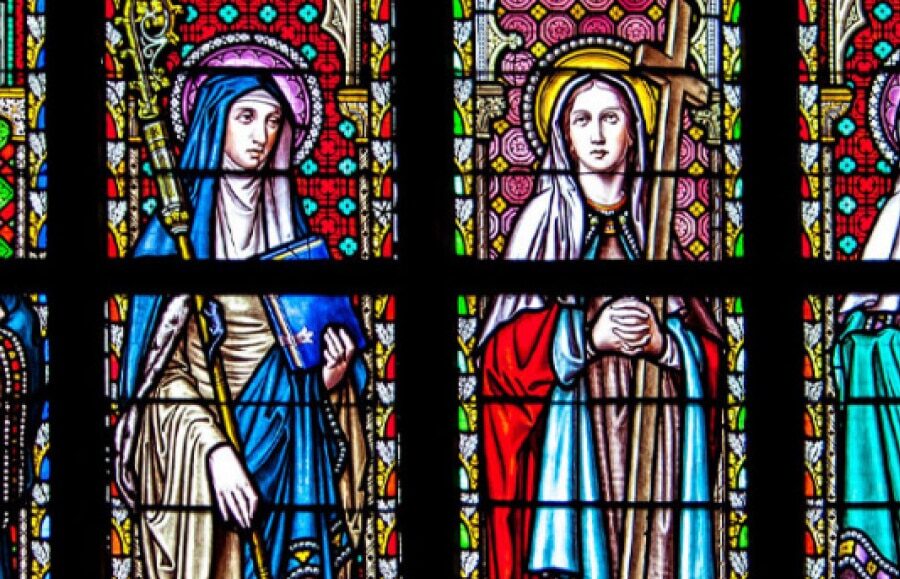Humor Beyond the Grave | ca. late third to early fourth century • Pre-Congregation Memorial: October 6
Read the accounts of the early Christian martyrs, and one type of story comes up again and again: A 12- to 14-year-old girl gets arrested during a persecution, is told to renounce her faith, refuses, and is tortured but refuses to apostatize. One thinks of Sts. Lucy, Eulalia, Agatha, Agnes, and too many others to count. It seems every region Rome ruled during this time has its own martyr whose tale follows this basic path. Some stand out, however. Consider Lucy and her eyes or Agnes and her miraculously growing hair. Or even the more obscure St. Faith of Conques.
She was a beautiful 12-year-old girl living in Agen, Aquitaine, France, during the coreign of Diocletian and Maximian. Her parents, wealthy pagans, left her rearing to a nurse, who happened to be Christian. Growing up in a beautiful, mosaic-encrusted villa, Faith had everything the world could offer, and her future looked bright, except for one thing: She had accepted her nurse’s Christian faith.
To understand why this was a problem, we must understand Emperor Diocletian. He had announced on assuming office his intention to revive morality within the realm, since immorality was sapping Roman virtue and therefore the empire’s viability and strength. He also believed a revival of the traditional Roman gods was key, because an empire united in its religious praxis would be stronger. This was not a problem for most pagans in most places, because gods were gods, even if their names varied by region. This was obviously not the case for Christians, however.
Diocletian launched a persecution designed to force everyone to the same cult. Dacian, prefect of the province in which Faith lived, came to Agen to observe his subjects’ loyalty—that is, to see if they were being good pagans and, if not, kill them.
While many Christians panicked, Faith voluntarily surrendered to the authorities. Imagine how frightened she must have been. She likely prayed for strength and for the words to convert her persecutors. Dacian probably had some nervousness too. After all, putting a twelve-year-old girl on trial would be a touchy situation, especially for a capital crime. Who wants to execute a child? Better to get her to apostatize, but how? During the trial Faith gave a brave, remarkable defense of Christianity. Fine, Dacian told her, keep your beliefs. Just sacrifice to the goddess Diana in the town temple.
Faith refused, and Dacian lost patience with the girl. He ordered her bound to a brazen bed and roasted. Pitch was thrown on the fire to make its flames flare and burn her legs. This happened in public so that the crowds could witness the fate awaiting Christians.
The problem for Dacian was that little Faith refused to cooperate. She cried, yes, but she didn’t scream or beg for mercy. After a miraculous rainstorm extinguished the flames, Dacian had her beheaded. Seeing all this, the mob was moved not to contempt for Christianity but to pity for Faith. Their only contempt was for Dacian, the child executioner. They wondered what god of theirs could give a mere maiden such strength. Realizing the answer was “None,” many converted on the spot. In turn, most of these received martyrdom twenty days later.
After her death St. Faith developed a reputation as something of a practical joker. If someone was stingy with a donation left for her shrine’s upkeep, small misfortunes might befall them. For instance, a dying woman promised St. Faith she would will her most precious ring to the abbey. Afterward her husband—possibly for its sentimental value, or maybe the thing had cost him a good deal of money—thought better of his wife’s last pledge. He instead used the ring as his second wife’s wedding band. Shortly the ring finger of the new missus swelled so much that it became unbearably painful. The couple beat a hasty path to the shrine. There, when the lady blew her nose, the ring flew off her hand with such force that it left a crack in the pavement.
On another occasion, Faith’s prayers restored sight to a man named Guibert, whose eyes had been torn from their sockets. Wanting to keep the recipient of so great a miracle close, the monks who cared for St. Faith’s shrine gave him the job of selling candles. It seems Guibert was a good businessman and soon became quite rich. But as so often happens, when success came, devotion to Our Lord went.
St. Faith reproached Guibert for his ingratitude. She had prayed Jesus would restore his sight, and this is how Guibert repaid her? So Guibert lost sight in one eye. This happened repeatedly: He would mend his ways, gain his eye, grow successful again, fall into sin, lose the eye, and so on.
A modern-day monk relates how the monks will occasionally parade Faith’s relics around the monastery grounds. With the greatest pomp, they process while holding candles, and they sing all day. By evening they are exhausted and famished. The monk says that once when many people had prayed, the intercession of St. Faith wrought many miracles. With each miracle the monks would sing a Te Deum. At the end of the day, the monks sat down under a tree to have a picnic, but each time they were about to sink their teeth into their meager food, someone would cry, “A miracle!” and the monks would have to get up and sing again. The reliquary holding St. Faith’s skull looks incredibly lifelike, especially the eyes. They seem to look right at the observer. Maybe that is why Faith is the patroness of those with eye problems.
Thirty-eight churches in England alone are named after St. Faith. There are many more in northern Spain and southern France, and her fame spread to the Americas via the conquistadors. Indeed, at least four cities in the United States are named after her, including Santa Fe, New Mexico. And in Brazil alone 22 cities bear her name.
Why St. Faith deserves our attention and devotion
Except for what she said in court, St. Faith never preached. She never wrote an epistle. Her preaching and writing were her actions. The bravery and resolve of this young maiden astounded the crowds. Perceiving something special about the God she worshiped, they converted. And she was just a child. God makes up for what we lack.
Holy Spirit, through your ineffable gifts, draw us to constant conversion. Renew our hearts. Let our actions preach eloquent sermons that draw people to Christ far better than our poor words can. Help us to love you, God, to do everything for you, and to remain firm in that love come what may, so that, with St. Faith, we may wear an eternal crown.









2 thoughts on “Saint Who? Faith of Conques”
St Faith pray for us 🙏🕯🌹🕊❤️
My name is Faith Hope Love
I feel a deepend connection to Saint Faith as I to have many Miricles in my life. I was blessed by Jesus Christ with 2 Angels when I was 5 years old.
They have been with me my entire life.
You see having unwavering Faith in God is a lifetime dedication to Christ Jesus. You have to be selfless even until death, even if your Faith brings you to death. In Faith you do not Fear Death because in true Faith you have Eternal life in Jesus Christ. Amen